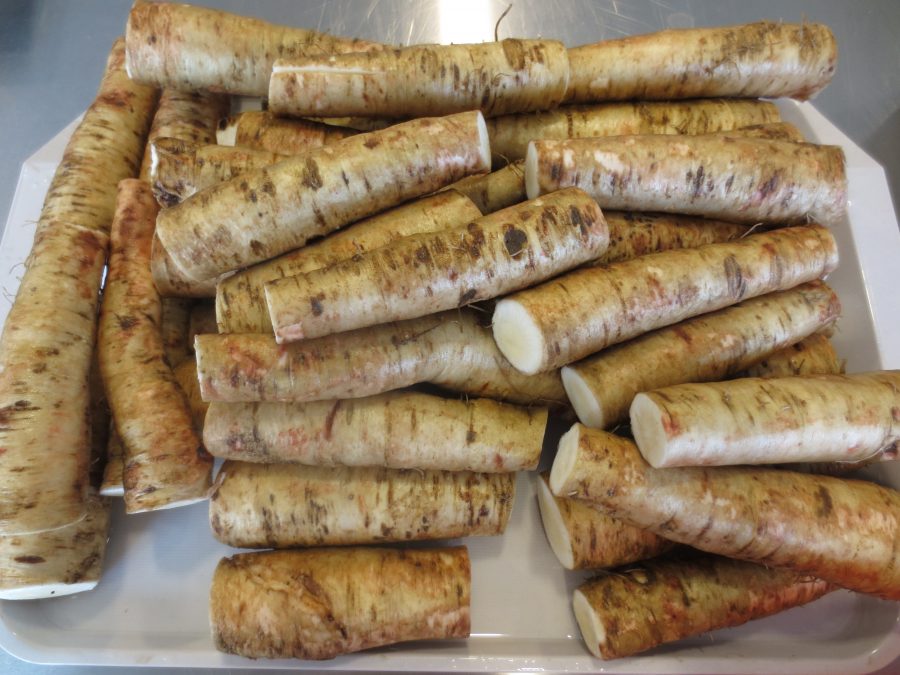Press release Upcycling-success with Belgian endive root: from by-product to 100% high-value, healthy, feasible and market-ready!

PhD student drastically simplifies the extraction of useful components
In Belgium, France, the Netherlands, Italy and Germany, 630,000 tons of Belgian endive heads are produced each year. The large tap roots on which they grew can now be valorized beyond fodder, into dietary fibers with highly valued properties, into bitters for the soft drink industry, into natural growth promoters for plants, and into natural antioxidants or disinfectants in cosmetics. What is groundbreaking, however, is that, through Anna Twarogowska's UA/ILVO PhD, the process of separating all these useful substances from the raw roots has been completely rethought into an efficient, waste-free and, above all, simple procedure. "I was aiming for a low-cost, sustainable, zero-waste biorefinery. The existing labor-intensive fractionation techniques such as flash chromatography and thin-layer chromatography were definitely too high a (costly) threshold for companies wanting to go circular."
Anna Twarogowska defended her doctoral thesis on 30 June 2022: ‘Transformation of Belgian endive by-products into valuable products by applying a zero-waste biorefinery concept”. Promotors were Prof. Dr. Luc Pieters (Antwerp University) en Dr. Ir. Bart Van Droogenbroeck (ILVO)
Belgian endive roots: continual, regionally concentrated, interesting by-product
Big white roots are left over after the white Belgian endive heads are harvested. These roots were found to be rich in sugars, a gluten-free dietary fiber and bioactive compounds such as phenolic compounds and the bitters sesquiterpene lactones. Those components are surprisingly stable, the researcher discovered. Different varieties grown in different locations nevertheless showed similar concentrations of useful compounds and similar properties.
A series of tests on the processability of the first fraction: the bulk fraction of dried Belgian endive root fiber, gave favorable results. Experimental veggie burgers, in which soy protein was replaced by Belgian endive fiber at a rate of 5 to 10%, showed a nice bake effect (read: little loss of water and volume and an oil retention capacity) after preparation, as well as a pleasant juiciness, without causing a strong distortion of the intended flavor balance. "These meat substitutes contain fewer calories, less sugar and twice as much fiber, and most importantly, the chicory ingredient is gluten-free. From >6 g per 100 g, companies are allowed to put the claim "high-fiber" on the packaging. So the new fiber powder could mean a commercial and a health added value for food producers and consumers."
The second, aqueous fraction includes sesquiterpene lactones. These components are responsible for the typical mildly bitter taste of chicory. Once isolated, these components can therefore be used in food as bitter substances. But they also appear to be useful in beauty products because of their antibacterial, antioxidant, anti-inflammatory and even analgesic effect. This has been extensively documented in the scientific literature. (Editor's note: ILVO is conducting further research into the production of plant-based functional components for cosmetic applications in the InnCocells research project). In addition, there are also opportunities for the bioactive components from the aqueous fraction as bio-stimulants for plants (better leaf and root growth), as recently confirmed in the Bio2Bio project . Both fractions from the chicory root biorefinery process in itself thus already offer good business opportunities in the bioeconomy, emphasizes co-promotor Bart van Droogenbroeck.
Simplified chopping and extraction using water and mixture of acetic acid and ethanol
Separating the above components from the fresh raw chicory roots can now be done through a greatly simplified procedure that produces no waste at the end (zero-waste). The process consists of two steps, with the simple use of water in step 1 and a spray dryer and ethyl acetate water as solvents in step 2.
Ethyl acetate is a mixture of concentrated acetic acid with distilled ethanol. In candy and perfume it is added for its fruit scent, but in other concentrations it also acts as a solvent during extraction processes (extracting caffeine from coffee beans or tea leaves, for example)."We shred the roots and then soak the shreds in several portions of warm water for several hours. The solid fraction can be stabilized in a drying oven, and then ground into a concentrated dietary fiber. The separated soaking water containing the soluble compounds such as sesquiterpene lactones from the root is misted in a spray dryer to concentrate, collect and stabilize the interesting components present."
Conclusion: Less food waste, higher value
This research makes a considerable step in valorizing the by-products from Belgian endive production into value-added products. The forced roots were 'upcycled': previously they were only used as fodder or compost, and now as functional food ingredients that can be processed in various food applications. They can improve the nutritional value of the product and its functional properties. The spray-dried stabilized aqueous fraction was also found to be usable as starting material for extracting valuable bioactive compounds that can be used as active ingredients in (plant) beauty products and bio-stimulants. "And all that while actively preventing food loss and waste, that is bio-economy at its finest," concludes co-promoter Bart Van Droogenbroeck.